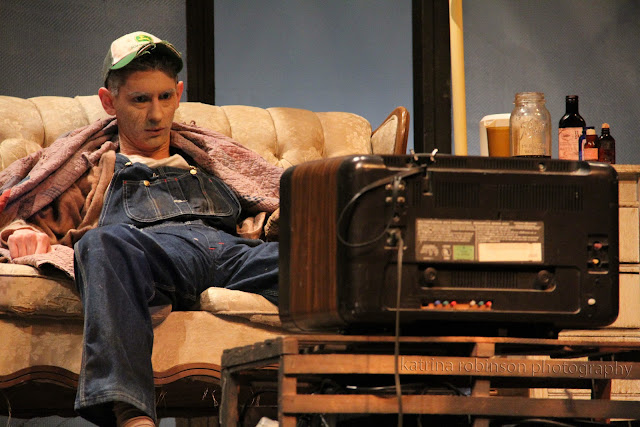 |
| Vande Zande reading from his novel at the Roethke House |
story and photos by Janet I. Martineau
A Midland author and the Saginaw-based Friends of Theodore Roethke received a late -- but wonderfully notable -- Christmas present over the weekend.
“American Poet -- A Novel “ penned by Jeff Vande Zande, a professor of English at Delta College, was announced Sunday as one of the 20 Michigan Notable Books 2013 chosen by the Library of Michigan -- out of 200 nominees.
Its fictional storyline revolves around a young poet’s effort to save Pulitzer-winning poet Roethke’s real-life boyhood home at 1805 Gratiot, which is owned and operated by the Friends group.
“This is great news for Jeff and for the Roethke House,” says Annie Ransford, the president of the Friends of Roethke board. “His novel helps save the house in fiction and now in reality too.
“I think we are most fortunate to have such a fine writer represent Saginaw's writing house. I enjoy the mix of prose and poetry Vande Zande's writing showcases, and that his first-class novel honors a first class poet.”
Vande Zande concurs, and says he will use this honor to “talk about the Roethke house. Not only does it play a role in this fictional novel but it has implications on the real world too.
“I wrote it with the goal of bringing attention to the house, and now that attention will.increase.”
With a chuckle he recalls driving past the house a number of times and getting an odd mental image of a kid up on its roof with a bullhorn in his hands and wondering why that kid was up there.
“Now I realize the kid was trying to save the house” ... and that eventually flowed into Vande Zande’s 155-page novel, published in February by Bottom Dog Press. He even wrote some of it at the house during an overnight stay.
 |
| Cover of the novel |
And since its release “party” in March -- at the Roehke House -- Vande Zande has donated $3 of its $18 price to the Friends group during several of its events. That sum he says, stands at $500 so far.
As for the Michigan Notable Books organization, at the end of each year it releases its list of 20 notable books published in that year; books that spotlight stories from the Great Lakes State or which were written by Michigan-connected authors. A committee of librarians, reviewers, booksellers and authors select the books.
Then in the following year (which is why Zande Vande is on the list of 2013 winners) the authors collectively visit 50 libraries around the state to talk about their books and careers.
Other winners in the 2013 list include include pitcher Jim Abbott's biography and a biography about the state’s first governor, a study of the Kirtland’s Warbler bird, short stories set in Northern Michigan, poetry about the nuances of daily relationships, the wild “Summer of ’68,” an illustrated volume on amphibians and reptiles, and photo books featuring Detroit's historic places of worship and Michigan's historic railroad stations.
In its release, the Notable Books committee said of Vande Zande’s “American Poet”: Saginaw is the setting for this short novel, a coming-of-age story of a young poet returning home after graduating from college. Vande Zande's story circles from documenting the survival of a failed relationship, finding beauty and value in a broken city, locating common ground with an aging father and orchestrating a plan to save the Theodore Roethke House.
A quote on the back cover of the book, by Gina Myers, says in part: “Vande Zande has written a love poem for the city of Saginaw, and, by extension, a love poem for Flint, Gary, Cleveland, or any forgotten city in the Rust Belt.”
Vande Zande, a native of Marquette who has taught creative writing and screenplay writing at Delta since 1999, has published three novels, two collections of short stories and one book of poetry so far.
“All of my novels are set in Michigan. It is the landscape I am most familiar with, and I want to reflect landscape in what I write. Michigan surely is a rich place for writers -- the bridge, wilderness, Upper Peninsula, cities, cars.
“I am really excited by this honor, humbled and blown away by it.”
He and the Friends group have known the book was in contention for the notable list since September -- when a member of the selection panel came to the Roethke house during a premiere showing of a film short taken from a chapter in the book, which Vande Zande and fellow Delta professor wrote and filmed.
“I have held my breath since and tried not to think about it.”
Earlier “American Poet” won Saginaw Valley State University's Stuart and Vernice Gross Award given to authors.
As for Roethke, he was born in Saginaw in 1908 and died of a heart attack, at age 55, in 1963. He is buried at Oakwood Cemetery in Saginaw Township.
He wrote nine books of poetry and received the Pulitizer in 1953, for “The Waking.” The son of a greenhouse owner, many of his poems reflect the natural world. And since the home was occupied by his sister all of her life, many of his poems were written in 1905 Gratiot during his visits there.
Today Roethke’s works appear in nearly all of the world’s textbooks and anthologies.














